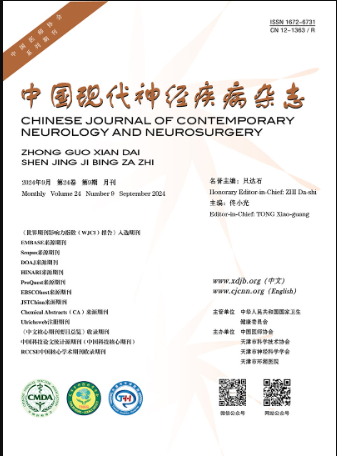A single-center study on endovascular thrombectomy for acute ischemic stroke
Q4 Medicine
引用次数: 0
Abstract
Objective To evaluate the efficiency and safety of endovascular thrombectomy for acute ischemic stroke caused by acute large vessel occulsion. Methods A total of 41 patients with acute ischemic stroke caused by acute large vessel occulsion were treated with endovascular thrombectomy. Time from onset to admission, from admission to femoral artery puncture, from onset to recanalization were recorded. Modified Thrombolysis in Cerebral Infarction (mTICI) was used to assess the recanalization immediately after operation. National Institutes of Health Stroke Scale (NIHSS) was used to evaluate the neurological function at 24 h after operation. Modified Rankin Scale (mRS) was used to evaluate clinical prognosis at 90 d after operation. Perioperative procedure-related complications and occurrence rate of symptomatic intracranial hemorrhage within at 90 d after operation were recorded. American Society of Interventional and Therapeutic Neuroradiology/Society of Interventional Radiology (ASITN/SIR) Collateral Flow Grading System (ACG) was used to assess collateral compensation of anterior circulation. BATMAN score was used to assess collateral compensation of posterior circulation. Results Among 41 patients, 12 (29.27%) were treated with recombinant tissue-type plasminogen activator (rt-PA) intravenous thrombolysis. There were 32 patients (78.05%) achieved successful recanalization, including 20 patients (80%, 20/25) in anterior circulation and 12 (12/16) in posterior circulation, and no significant difference was seen between them (adjusted χ 2 = 1.424, P = 0.706). At 24 h after operation, 28 patients (68.29%) had better neurological function than preoperation (NIHSS decreasing ≥ 4 score), including 18 patients (72%, 18/25) with anterior circulation occlusion and 10 (10/16) with posterior circulation occlusion, and there was no significant difference between them (χ 2 = 0.407, P = 0.524). Eleven patients (26.83%) died within 90 d after operation, including 4 patients (16%, 4/25) with anterior circulation occlusion and 7 (7/16) with posterior circulation occlusion, and there was no significant difference between them (adjusted χ 2 = 2.130, P = 0.144). Among the 11 dead, 3 died of complicated pulmonary infection and respiratory failure, and 8 died of ischemic stroke. The other 30 patients were followed up for 3 months to one year, average (231.92 ± 95.36) d. At 90 d after operation, 14 patients (34.15%) had good outcome (mRS ≤ 2 score), including 10 patients (47.62%, 10/21) with anterior circulation occlusion and 4 (4/9) with posterior circulation occlusion, and there was no significant difference between them (adjusted χ 2 = 0.493, P = 0.483). Among 41 patients, 6 patients (14.63% ) had symptomatic intracranial hemorrhage, including 4 patients (16% , 4/25) with anterior circulation occlusion and 2 (2/16) with posterior circulation occlusion, and no significant difference was seen between them (adjusted χ 2 = 3.303, P = 0.856). Collateral compensation was evaluated in 33 patients (20 with anterior circulation occlusion and 13 with posterior patients circulation occlusion). In 20 patients with anterior circulation occlusion, 14 patients (70%) had good collateral compensation, in whom 9 (9/14) had good outcome 90 d after operation, while the other 6 patients (30%) had poor collateral compensation and then had good outcome 90 d after operation, and significant difference was seen between them (Fisher exact probability: P = 0.014). Among 13 patients with posterior circulation occlusion, 3 patients (3/13) had good collateral compensation and had good outcome 90 d after operation, while the other 10 (10/13) had poor collateral compensation, in whom one (1/10) had good outcome 90 d after operation, and significant difference was seen between them (Fisher exact probability: P = 0.014). Conclusions Endovascular thrombectomy is an efficient and safe method for acute ischemic stroke caused by acute large vessel occlusion. Rigorously master the indication and preoperative evaluation, and perfect acute rescue procedure and treatment for stroke may increase the efficacy of endovascular thrombectomy. DOI: 10.3969/j.issn.1672-6731.2017.11.005急性缺血性脑卒中血管内取栓的单中心研究
目的评价急性大血管闭塞致急性缺血性脑卒中血管内取栓术的有效性和安全性。方法对41例急性大血管闭塞致急性缺血性脑卒中患者行血管内取栓术。记录发病至入院时间、入院至股动脉穿刺时间、发病至再通时间。采用改良脑梗死溶栓(mTICI)评价术后立即再通情况。采用美国国立卫生研究院卒中量表(NIHSS)评价术后24 h神经功能。采用改良Rankin量表(mRS)评价术后90 d的临床预后。记录围手术期相关并发症及术后90 d内症状性颅内出血发生率。采用美国介入与治疗神经放射学会/介入放射学会(ASITN/SIR)侧支血流分级系统(ACG)评估前循环侧支代偿。采用BATMAN评分评估后循环侧支代偿。结果41例患者中12例(29.27%)采用重组组织型纤溶酶原激活剂(rt-PA)静脉溶栓。再通成功32例(78.05%),其中前循环20例(80%,20/25),后循环12例(12/16),两者差异无统计学意义(校正χ 2 = 1.424, P = 0.706)。术后24 h, 28例(68.29%)患者神经功能优于术前(NIHSS评分降低≥4分),其中前循环闭塞18例(72%,18/25),后循环闭塞10例(10/16),两者差异无统计学意义(χ 2 = 0.407, P = 0.524)。术后90 d内死亡11例(26.83%),其中前循环闭塞4例(16%,4/25),后循环闭塞7例(7/16),两者差异无统计学意义(校正χ 2 = 2.130, P = 0.144)。11名死者中,3人死于并发肺部感染和呼吸衰竭,8人死于缺血性中风。其余30例患者随访3个月~ 1年,平均(231.92±95.36)d。术后90 d,预后良好(mRS≤2分)14例(34.15%),其中前循环闭塞10例(47.62%,10/21),后循环闭塞4例(4/9),两组间差异无统计学意义(校正χ 2 = 0.493, P = 0.483)。41例患者中有症状性颅内出血6例(14.63%),其中前循环闭塞4例(16%,4/25),后循环闭塞2例(2/16),两者差异无统计学意义(校正χ 2 = 3.303, P = 0.856)。对33例患者(前循环闭塞20例,后循环闭塞13例)进行侧支代偿评估。20例前循环闭塞患者中,14例(70%)侧支代偿良好,其中9例(9/14)术后90 d预后良好,6例(30%)侧支代偿较差,术后90 d预后良好,两者差异有统计学意义(Fisher精确概率:P = 0.014)。13例后循环闭塞患者中,3例(3/13)侧支代偿较好,术后90 d预后良好;10例(10/13)侧支代偿较差,其中1例(1/10)侧支代偿较好,术后90 d预后良好,两者差异有统计学意义(Fisher精确概率:P = 0.014)。结论血管内取栓是治疗急性大血管闭塞所致急性缺血性脑卒中有效、安全的方法。严格掌握适应证和术前评价,完善脑卒中急性抢救程序和治疗,可提高血管内取栓术的疗效。DOI: 10.3969 / j.issn.1672-6731.2017.11.005
本文章由计算机程序翻译,如有差异,请以英文原文为准。
求助全文
约1分钟内获得全文
求助全文

 求助内容:
求助内容: 应助结果提醒方式:
应助结果提醒方式:


